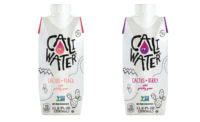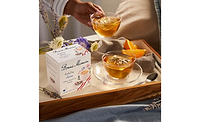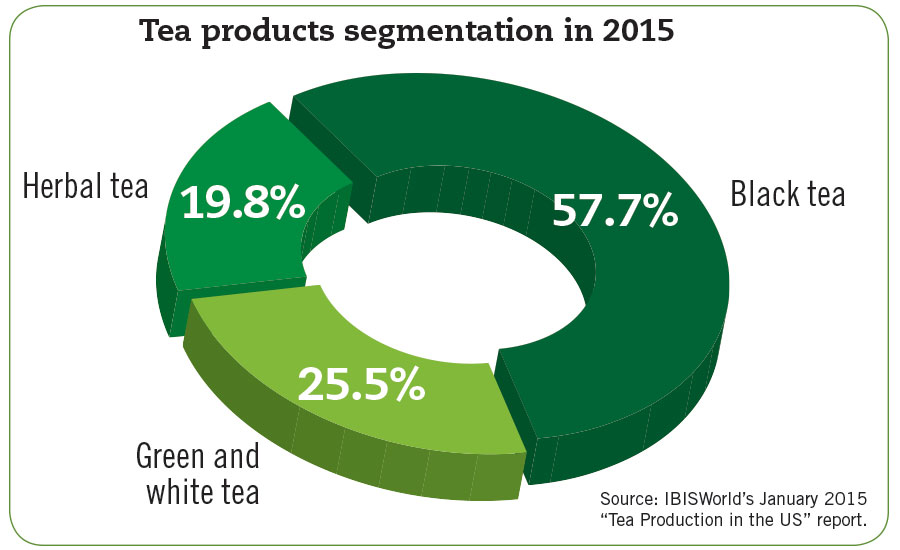Green, herbal teas experience growth
Tea ingredients focus on quality



Experts note continuing growth for green tea in all categories. Additionally, IBISWorld reports that the green and white tea segments account for approximately 22.5 percent of the industry’s revenue. (Image courtesy of Titan Tea)



As health-and-wellness trends proliferate in the marketplace, consumers demand products offering functional benefits as well as great flavor. Used for thousands of years, tea has been a popular go-to for many health-conscious consumers whether in bagged, ready-to-drink (RTD) or through non-traditional categories like sports drinks and spirits.
A January 2015 report from Los Angeles-based IBISWorld titled “Tea Production in the US,” highlights the growing emphasis on a healthy lifestyle that has shifted consumers toward healthier beverages, thus driving the growth of tea-based beverages and its use as a functional ingredient.
“Additionally, as Americans continue to become more health conscious, they are seeking flavorful alternatives to sugar-rich, carbonated beverages,” the report states. “Tea is also becoming more popular thanks to the growing variety of flavors, strengths and sweeteners offered by manufacturers.”
Keep on steepin’
According to the IBISWorld report, black tea continues to lead the tea market with an estimated 57.7 percent of the industry’s revenue. However, green and white teas are gaining ground and, as result, are decreasing black tea's market share, the report adds.
Gary G. Vorsheim, vice president of extract sales at Martin Bauer Inc., Secaucus, N.J., credits Americans’ taste for black tea as one factor for its lead. “In the U.S., black tea is where most consumers started with tea, and it has enjoyed hundreds of years of consumption, which has created a solid base of preference for black tea,” he says.
Having gained an awareness and understanding of tea, some consumers have begun to branch out to find new flavors and varieties. The IBISWorld report notes that the green and white tea segment accounts for an estimated 22.5 percent of the industry’s revenue.
“Tea is being used increasingly,” Lakeland, Fla.-based Treatt’s Group Vice President of Global Sales Douglas Rash says. “And green tea is growing at a much faster rate than black tea with a more than 60 percent increase in volume over the past 10 years, and continuous growth is expected.
“Black tea dominates, but green tea is encroaching on that territory,” he continues. “Green tea has a stronger association with wellness due to the higher catechin content.”
Alison Raban, certified food scientist and application specialist at BI Nutraceuticals, Long Beach, Calif., adds that U.S. consumers have become more comfortable with green tea. “I think it’s finally caught on that green tea has a lot of antioxidants,” she says. “And what we’ve found is our customers don’t have to say ‘Green tea is good for you.’ They can just say ‘Made with green tea,’ and that’s enough to get consumers interested.”
Matcha is one green tea varietal influencing the growth of the segment. Several experts note the additional health benefits of matcha compared with traditional green tea, which appeal to some consumers.
“Matcha is powdered green tea leaves, so it’s an even more potent source of nutrients than steeped green tea,” Edison, N.J.-based Allen Flavors’ Marketing Manager John Wilson says. “It’s also three-times as caffeinated. But fans of matcha say that its buzz is unlike the jolt of coffee — more like an alert calmness. Propelled by its healthful attributes and its zen properties, matcha is popping up in specialty drinks and on menus nationwide.”
According to Bill Driessen, director of tech sales in Central and Latin America for Minneapolis-based Taiyo International Inc., the entire leaf of the plant is ground to produce matcha powder. “Since it is insoluble, the beverages that use matcha as a flavor ingredient should have some body (thickness or viscosity),” he says. “Additionally, the flavor of matcha powder pairs very well with creamy tastes. ...It also provides a naturally occurring bright green color that consumers can easily relate to as healthy and wholesome.”
BI Nutraceutical’s Raban notes that herbal teas also have begun to show growth within the market. In fact, the IBISWorld report notes that the segment comprises approximately 19.8 percent of industry revenue. “Rising demand from the aging population is partly attributable to the intense marketing on the part of industry operators in an effort to boost awareness about the health benefits of herbal teas,” it states. “Consequently, herbal tea’s share of revenue is expected to grow in line with the industry during the next five years.”
With consumers growing acceptance of tea, the ingredient now is used in a variety of products. “Beverage-makers benefit from consumers’ global acceptance of tea,” Taiyo’s Driessen says. “Tea is a versatile beverage and can be used as a vehicle to develop beverages with added flavors or additional healthy ingredients.”
The millennial impact on the market demands more variety, and BI Nutraceuticals’ Raban notes that tea offers many ways to provide variety including exotic flavors and sources. “I think the overall trend in food and beverage is variety and more choice. …Consumers want more and more options,” she says.
She notes one way to add variety with tea is through blends, which offer exotic flavors or herbal varieties mixed with more traditional tea varieties.
However, Lauren Lamoureaux, technical director at Finlay Tea Solutions USA Inc., Florham Park, N.J., notes that tea is versatile not only with added flavors, but also as a functional ingredient in various beverage categories. “Tea is a great ingredient to use in myriad of beverages; it can be used in dairy beverages, juice, energy drinks and health-and-wellness drinks,” she says. “We have had success with, and feel, that teas are going to emerge more in the latte and smoothie-type beverages.”
Lamoureaux adds that tea also has potential growth in various categories. “…ready-to-drink is gaining popularity especially in the U.S., 85 percent of tea consumed in the United States is iced, and we see that growth continuing as well as broadening with hot and iced tea lattes, chai teas and tea smoothies,” she says.
Johns Creek, Ga.-based Amelia Bay’s Vice President John Crandall adds that sports drinks increasingly have been using green teas as they pair well with flavors and offer benefits for sports recovery.
Looking ahead, Treatt’s Rash notes that diversity using tea ingredients will continue. “We expect to see more diverse tea and flavor pairings, such as chai and pumpkin spice and tea lattes in the future,” he says. “Although the growth in tea products is strong, consumers are experimenting with new flavors and formats as well as looking for added health benefits. Tea’s versatility makes it the ideal beverage.”
Steeping it right
Although tea is a versatile ingredient, it is not without its own challenges. David Wasnak, associate director of marketing and consumer insights at Piscataway, N.J.-based Robertet Flavors Inc., notes that consumers now are looking for quality from their tea-based products as a result of the better-for-you trends as well as the movement away from carbonated soft drinks (CSDs). “The days of consumers perceiving any can or bottle of tea as a healthier alternative to CSDs are over. Now they are demanding products that are healthier for themselves as well as their families,” he says. “These products obviously aren't as sweet, placing much greater emphasis on the flavor and quality of the tea itself.
“Millennial interest in authenticity and complexity is another key driver here,” he continues. “As they cycle through flavor trends at a much faster rate than previous generations, millennials have begun to look around the globe for new flavor experiences. This, along with interest in authenticity, opens them up to higher quality teas. ...In the past, U.S. consumers might have thought of these products as too simple, ...but now they're finding the complex flavor of the tea itself to be just as appealing as the cleaner label.”
Taiyo's Driessen notes, however, that formulation with tea has hurdles that must be overcome to ensure both taste and quality. “Tea offers a variety of health benefits, most coming from its content of polyphenolic compounds,” he explains. “But those very same compounds can be challenging for product formulators to work with because of their inherent bitterness. ...So, when developing a product containing real tea, formulators should lean toward flavors that are also naturally bitter. For example, grapefruit and cranberry are flavors that have bitterness, so it will be less awkward to introduce the tea bitterness into the flavor profile.”
Kevin Goodner, product manager of extracts and essences at Synergy Flavors, Wauconda, Ill., adds that turbidity and sedimentation can present challenges when working with teas, depending on the product.
However, no matter what type of beverage tea is used in, experts say quality and ingredient format are critical to producing a high-quality end-product. “For a high-quality, hot tea the type of leaf tea used will be much different than the type of leaf tea used for a good bottle of RTD tea,” Martin Bauer’s Vorsheim says. “The application really defines the quality question, and then the formulator selects the right tea ingredient.”
Allen Flavors’ Wilson echoes similar sentiments: “The flavor of different tea formats, such as powdered, brewed and extracts can heavily impact a tea-based beverage. For example, powdered tea might have less flavor compounds than brewed tea or tea extracts. …Depending on which solvent is used to extract the tea, the tea can have some flavor compounds missing. Tea essences and tea flavors help bring back some of the original tea flavor notes.”
Wilson adds that the solubility of tea also can be a challenge, especially in developing RTD teas. “When developing an RTD using tea, the beverage must be homogeneous. The insolubility of some tea powders can be a challenge as the beverage must be consistent from bottle to bottle,” he explains. “Insoluble tea particles will cause what we call ‘fallout’ or sediment to appear on the bottom of the bottle and sometimes ‘ringing’ at the top of the bottle.
“To combat solubility challenges, tea suppliers have developed tea powders that are more soluble by reducing some of the insoluble tea components,” Wilson continues. “During this ‘cleaning up’ process, the tea can lose some flavor compounds. Tea essences and tea flavors are used to bring back the tea notes that we expect when drinking tea.”
As far as quality is concerned, Synergy Flavors’ Goodner notes two critical aspects for quality assurance — the raw ingredient and how the tea is processed. The first is ensuring the quality and availability of the raw ingredient. He says that a company should look at where the tea comes from, how it’s sourced and processed and whether there is enough to fulfill demand. “You have to have good tea coming in to have any hope of having a good final product,” he says.
The second aspect is the processing, such as how a product is brewed, made into an extract or a concentrate. “You have to have a very good raw material and a very good manufacturing process; the two really go hand-in-hand,” he says.
Amelia Bay’s Crandall adds that sourcing remains essential. Although the raw material might be available at a lower price, it also might not yield a consistent quality product batch to batch, he says. Because regulations are not universal, products leaving various countries are not held to the same standards upon export within other markets.
Taiyo’s Driessen adds that U.S. regulations must be considered. “It is very important for beverage companies to know and understand the regulatory aspects related to tea ingredients,” he says. “More specifically, they need to know if the ingredients they are sourcing are compliant with strict U.S. regulations for tea. There are hundreds (if not thousands) of possible agricultural residues (pesticides) that could be present in tea products. If your supplier only tests for a few of them, then that should be a warning sign.
“Likewise, the type of solvent being used in the extraction process is extremely important,” he continues. “Only hot water and/or ethyl acetate are approved for use as solvents for tea. Other solvents might offer higher yields at the end of the production process, and thereby lower prices. But it is not allowed and could be unhealthy.”
Looking for a reprint of this article?
From high-res PDFs to custom plaques, order your copy today!









